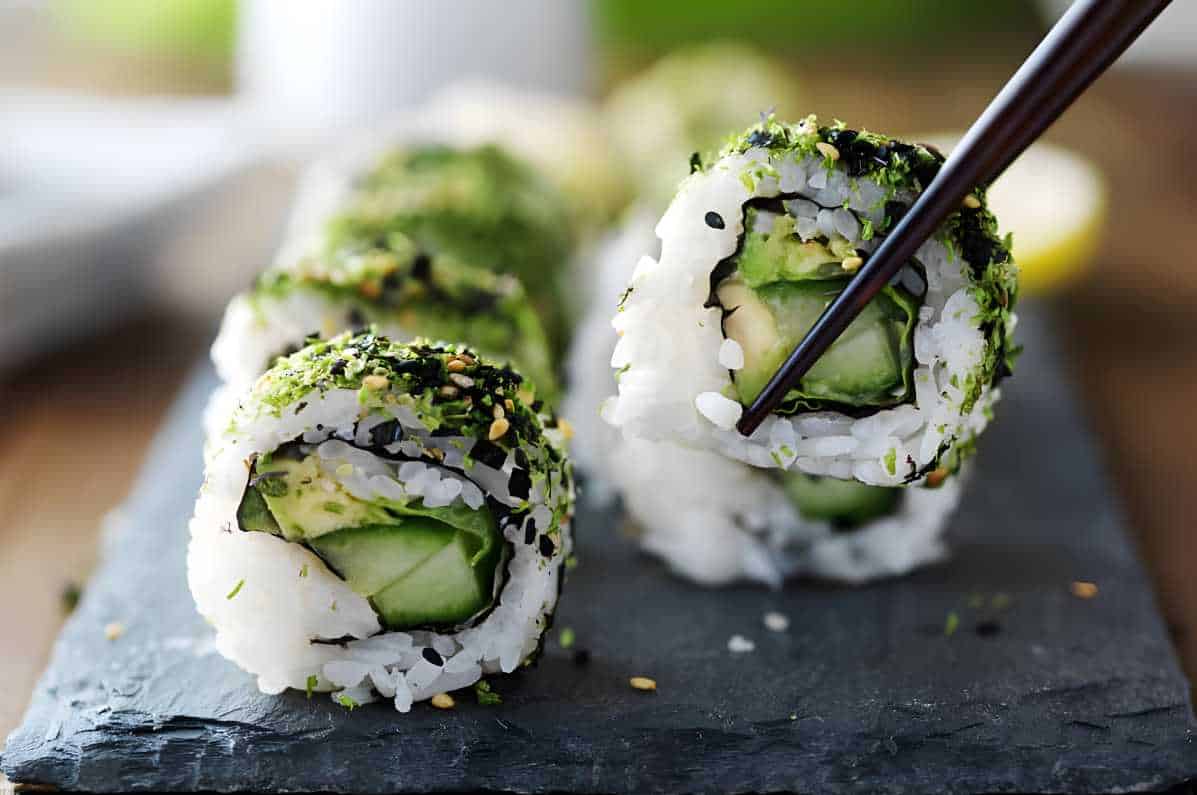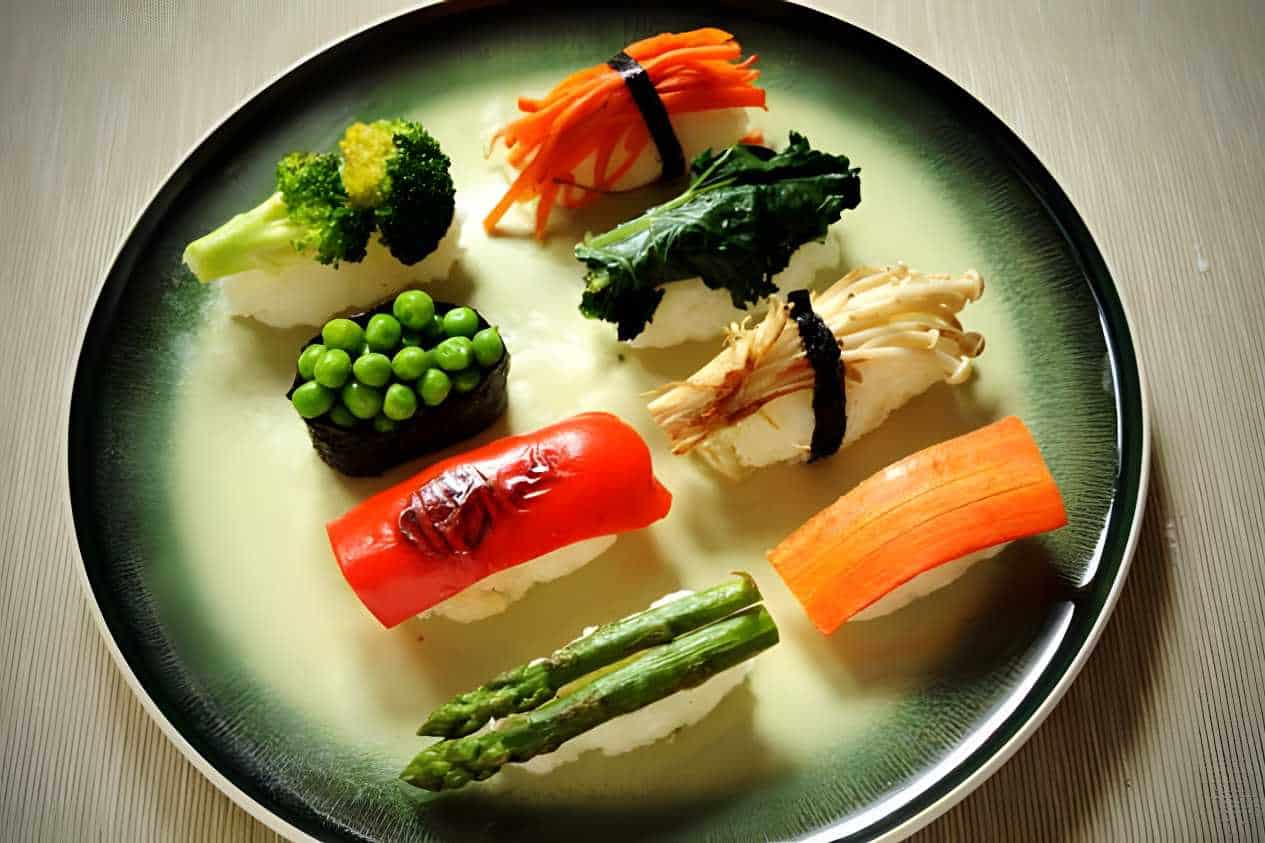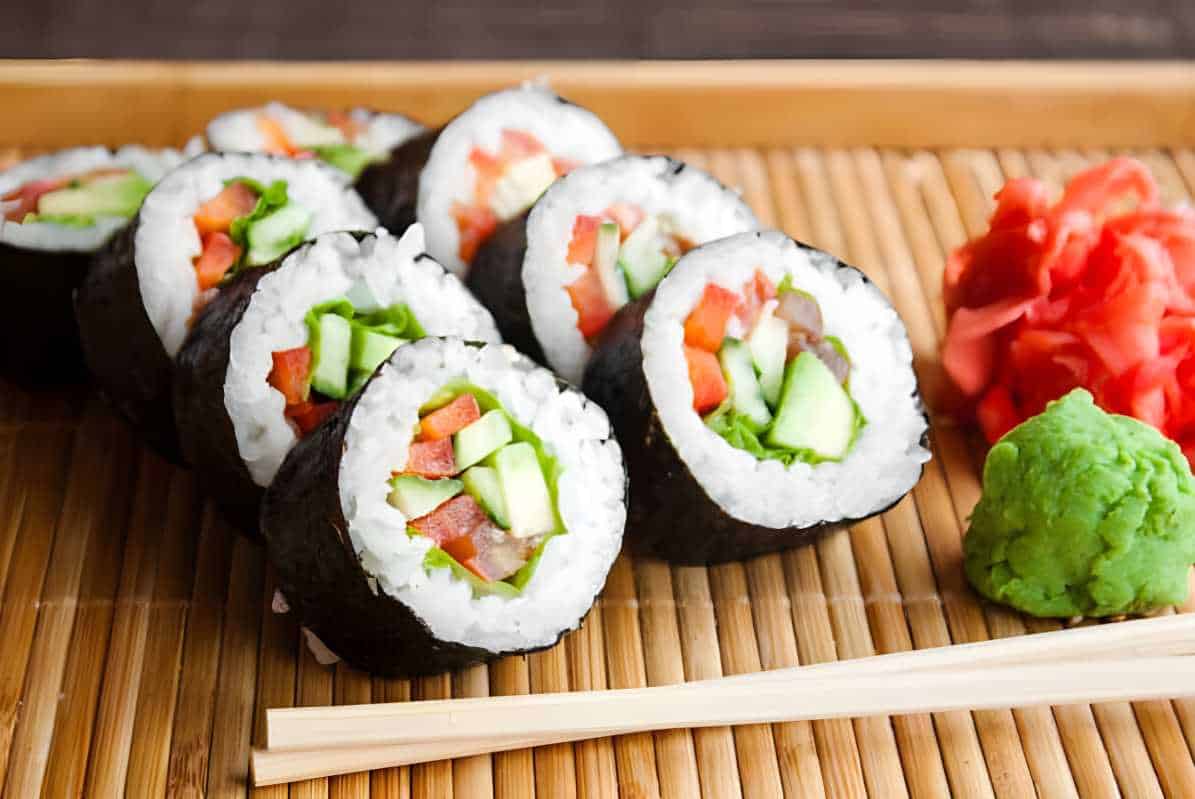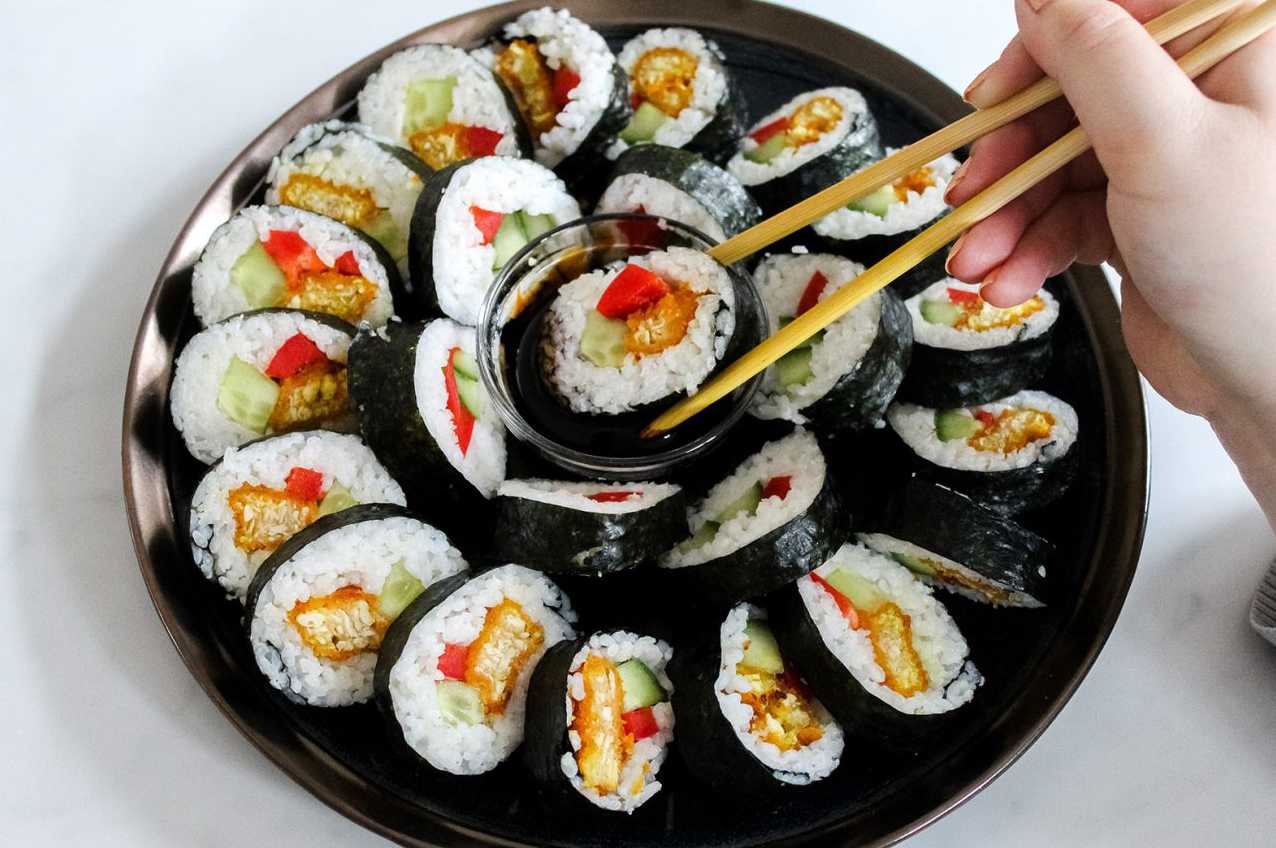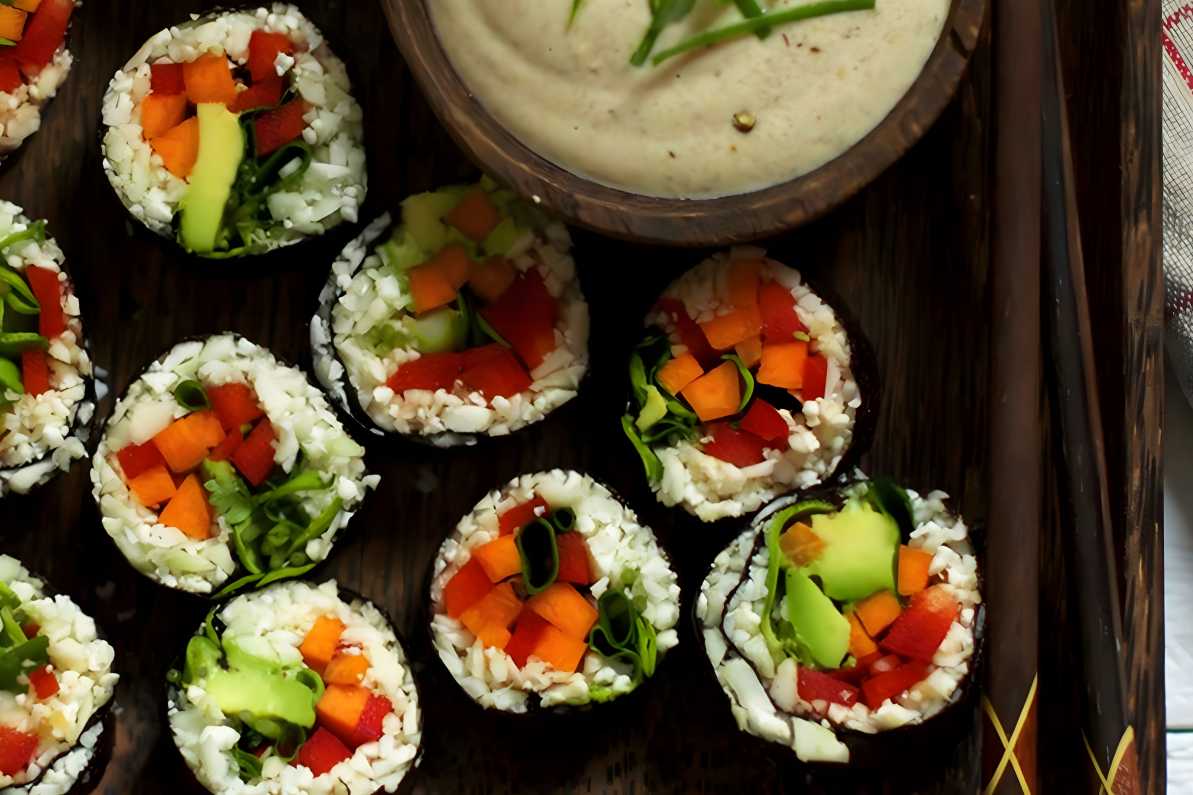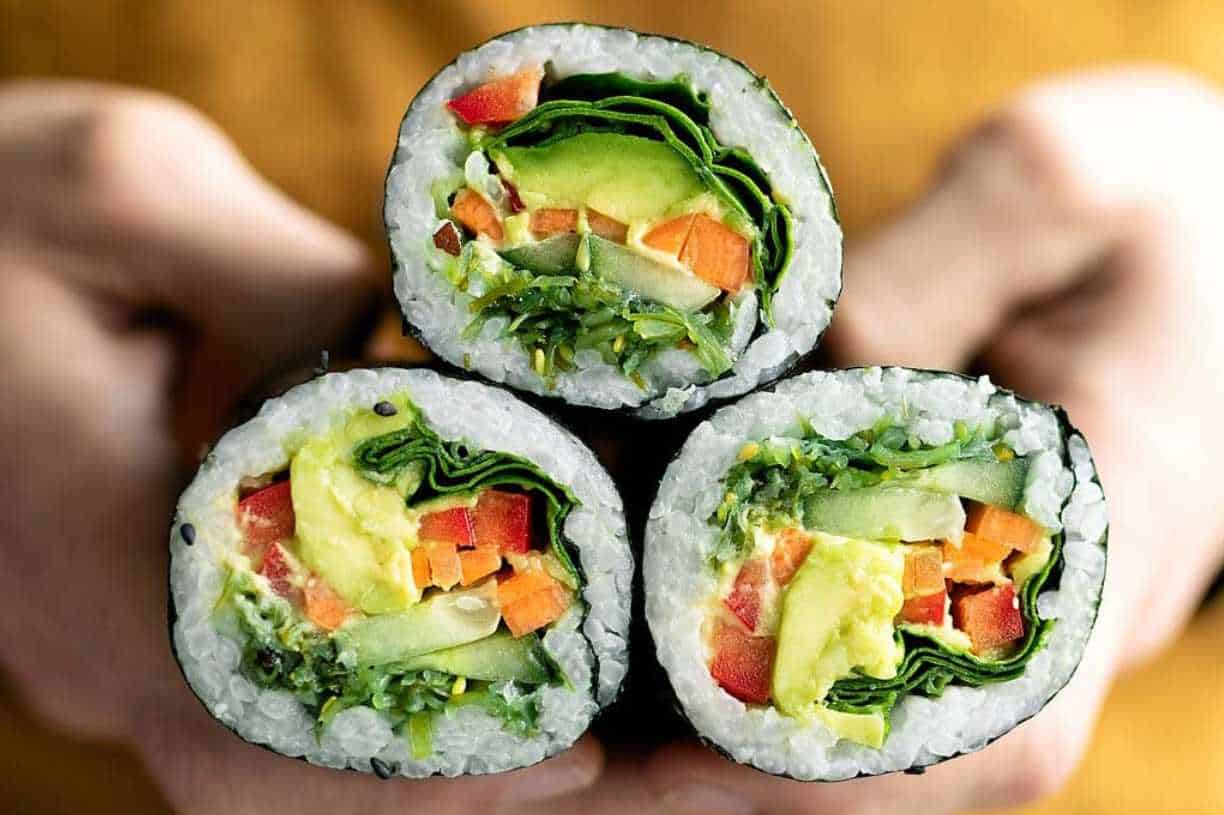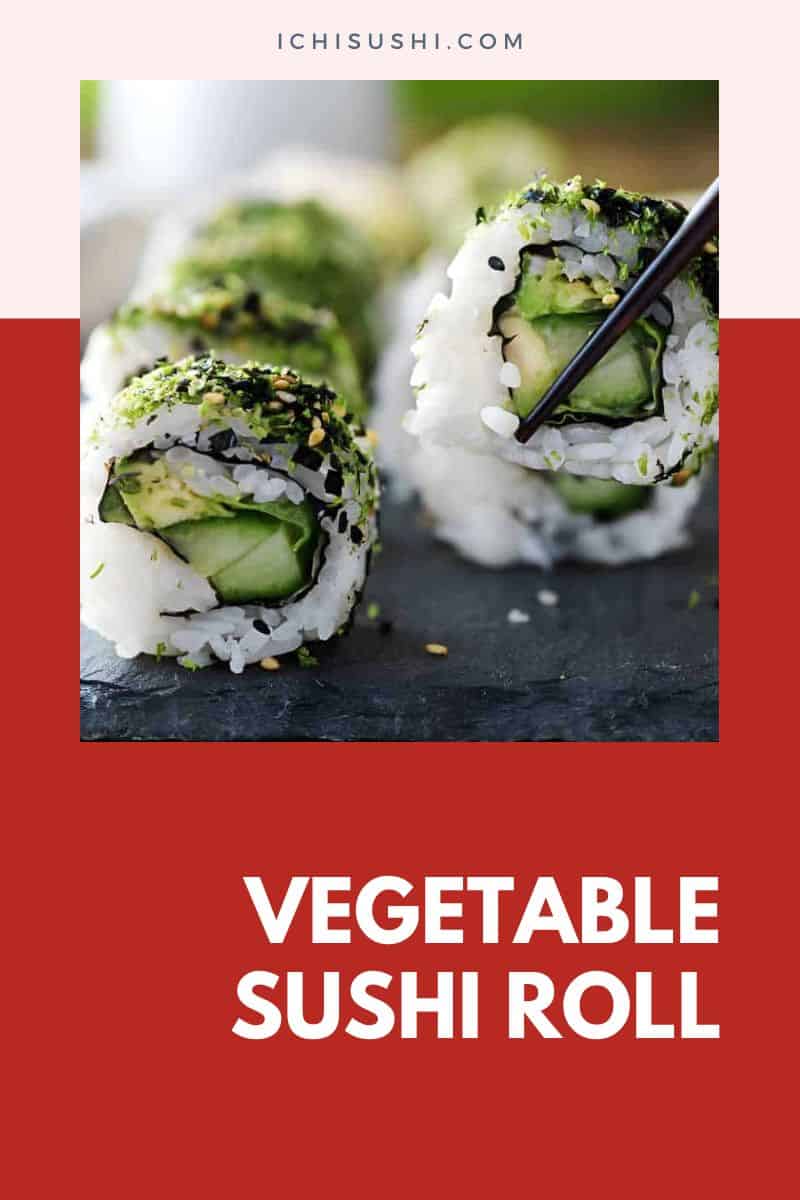If you’re craving some authentic Japanese food but do not want to pack on the pounds, eating vegetable sushi is a great alternative.
It’s low-calorie and packed with nutrients and fiber. Here is all you need to know about Vegetable Sushi Roll: Calories & Nutrition Facts.
What is a vegetable sushi roll?
A vegetable sushi roll is made from vinegared Japanese rice, nori wrapper, and fresh or pickled vegetables. This nutritious sushi roll is commonly served with pickled ginger, wasabi, hot sauce, or soy sauce.
What are the types of vegetable sushi rolls?
Commonly, sushi is made with raw or fermented fish and other seafood. However, chefs have created vegetarian and vegan options for those with dietary restrictions and health goals.
Vegetable Sushi, Nigiri Style
Nigiri sushi is made by taking a sticky rice ball and pressing it into oval-shaped sushi. Sushi chefs then top it with mushrooms or other vegetables.
Nasu Nigiri
Nasu, or eggplant in Japanese, is either pickled or grilled to bring out its flavor. Grated ginger goes well with this succulent sushi.
Avocado Nigiri
This soft and buttery fruit is a common ingredient in different kinds of sushi. Chefs top the sticky rice with avocado that’s seasoned with salt. A thin strip of nori fastens the rice and avocado for a delicious vegan option.
Vegetable Maki Sushi
One of the most sushi kinds is maki which means ” rolled” in Japanese. A sushi chef prepares it by spreading rice over a nori sheet and arranging fillings in a row. Then, they roll it up and slice it to reveal its colorful fillings.
Kappa Maki
This refreshing sushi is made by wrapping a slice of cucumber with sticky rice and seaweed. Sushi enthusiasts use this as an appetizer or palate cleanser before eating heavier Japanese food.
Takuan Maki
Sushi chefs make this delightful and tangy sushi by wrapping pickled radish or “takuan” with rice and seaweed. The result is a combination of crunchy and soft textures.
Kampyo Maki
Sushi diners often order pickled gourd or kyampo sushi at the end of a meal since it can aid digestion. The pickled brown vegetable has a similar taste to sweetened soy sauce.
Ume and Cucumber Shizo Maki
The refreshing combination of Japanese pickled plum (ume), shiso (perilla herb), and cucumber are usually served towards the end of a meal and sometimes in between courses.
How healthy is sushi roll?
Sushi Roll Calories
Generally, a 100-gram vegetable sushi roll contains 92 calories. On the other hand, a slightly larger roll weighing 190 grams has 175 calories.
Adults with a medium weight who eat these rolls would only consume about 7% of their daily calorie intake.
Another way to look at the number of calories is by counting them per roll. A typical roll has 30 calories per piece, totaling 350 calories per 12-piece roll. Adding the following condiments will result in additional calories:
| Condiment | Amount | Number of Calories |
| Soy sauce | 1 tablespoon | 11 calories |
| wasabi | 1 teaspoon | 15 calories |
| Pickled ginger | 2 tablespoons | 25 calories |
A Breakdown of Vegetable Sushi Calories Per Ingredient
Here is the caloric breakdown of each ingredient in one roll of vegetable sushi using white rice.
| Ingredient | Amount | Calories |
| Sushi rice | 0.35 cup | 83 calories |
| Nori | 1 sheet | 8 calories |
| avocado | 0.33 grams | 76 calories |
| asparagus | 60 grams | 13 calories |
| cucumber | 60 grams | 7 calories |
On the other hand, here is the caloric breakdown of each ingredient in one roll of vegetable sushi using brown rice.
| Ingredient | Amount | Calories |
| Brown rice | 0.35 | 76 calories |
| Nori | 1 sheet | 8 calories |
| avocado | 0.33 grams | 106 calories |
| asparagus | 60 grams | 13 calories |
| cucumber | 60 grams | 9 calories |
| Green onion | 60 grams | 19 calories |
The following food and drinks are equivalent to the calories from a medium-sized veggie roll. This list will help you visualize how much the calories are:
- 1 ½ slice of cheese
- 1 ½ piece of bread
- 9 sugar cubes
- 3 apples
- 1 glass of milk
- 2 220-ml glasses of soda
If you want to burn the calories you’ve consumed after eating vegetable sushi, you can do the following activities:
- Swim for 21 minutes
- Run for 18 minutes
- Bike for 25 minutes
Is vegetarian sushi a good option?
Choosing the correct type of sushi makes it a good option for when you are watching your weight or trying a healthier lifestyle. Vegetable sushi with a brown rice base is more nutritious since it has more complex carbohydrates and protein.
What are the nutritional facts of vegetable sushi?
Eating vegetable sushi can be good for you whether you’re a vegetarian. It has lower calories than the typical fish sushi, and the vegetables contain a wide array of vitamins and minerals.
To give you a glimpse of the nutritional value of veggie sushi, here’s a dietary facts chart.
Nutrition Facts for One Roll of Vegetarian Sushi (about 289 grams)
| Amount | % Daily Value | |
| Calories | 206 | |
| Calories from Fat | 74 | |
| Total Fat | 8.2 grams | 13% |
| Saturated Fat | 1.2 grams | 6 % |
| Trans fat | 0 grams | 0% |
| Cholesterol | 0 grams | 0% |
| Sodium | 153 mg | 6% |
| Potassium | 663 mg | 19% |
| Total Carbohydrates | 30 grams | 10% |
| Dietary Fiber | 6.4 grams | 26% |
| Sugar | 5.4 grams | |
| Protein | 6.6 grams | |
| Vitamin A | 27% | |
| Vitamin C | 37% | |
| Calcium | 8% | |
| Iron | 15% |
It’s vital to note that the percent daily values are based on a 2000-calorie diet.
What are the health benefits of vegetable sushi?
Vegetable sushi has rice and vegetables as its primary ingredients. Check out some of the standard components of vegetable sushi and their health benefits.
Vinegared Japanese Rice
Japanese rice has many nutritional elements that can make a meal more balanced. It contains vegetable protein that supplies vital energy and helps build healthy cells.
This kind of rice also contains calcium that supports bone and tooth health. Furthermore, it has a healthy dietary fiber to aid digestion and optimal gut health.
On the other hand, rice vinegar is rich in vitamins and minerals to boost immunity. It also has anti-oxidant and antiseptic properties.
Avocado
Avocados are an excellent source of vitamins B6, C, E, and K. It’s rich in niacin, folate, riboflavin, pantothenic acid, potassium, and magnesium.
You’ll also benefit from lutein, omega-3 fatty acids, and beta carotene found in avocados. The healthy fat content of this creamy fruit helps keep people feel full between meals.
Cucumber
Cucumber is a refreshing vegetable that’s rich in potassium and magnesium. It’s perfect for weight watchers since it’s low in calories but high in essential vitamins and minerals.
How to Watch Out For Hidden Calories in Sushi
Vegetable sushi may have lower calories than those that contain fish. However, if you’re not careful, you may be consuming more calories than you intended. Here are some tips to avoid hidden calories when ordering sushi.
- If you’re craving spicy food, but watching your weight, it would be best to avoid spicy sushi on the menu. Usually, the sushi spicy ingredient is mayonnaise laced with chili. This rich condiment can pack an additional 99 calories.
- Avoid ordering tempura sushi so you won’t be consuming oil during your meal. Tempura means deep-fried in Japanese. A harmless vegetable like an eggplant can have more calories when served tempura style.
- Try not to consume a lot of sauce since it may contain a lot of sodium and sugar. Good sushi is already tasty, so adding sauce will give you more calories and may drown the natural flavors of your meal.
- Savor every bite and eat slowly during your meal. It takes time for your brain to realize that you are full. You may not notice you’ve consumed a lot of sushi when you eat at breakneck speed. If you take your time to chew your food, you will be able to appreciate all the flavors without consuming extra calories.
- Ask the chef or server to slice your sushi into eight pieces rather than six. Having more pieces on your plate will give you the illusion that there is more food on your plate. It will also allow you to eat at a slower pace. Avoid dipping your sushi in soy sauce. This condiment contains sodium and sugar that can also add to the meal’s total calories.
- It will help boost the fiber content of your meal to keep you satisfied longer. You may order edamame or seaweed salad to go with your vegetable sushi. It can be an enjoyable dining experience, and indeed you’ll feel good and healthy afterward.
Summary
Sushi is an integral part of Japanese cuisine that many people love worldwide. Vegetarians and non-vegetarians have an option that they can enjoy.
Even those watching their weight can savor the delectable flavors of sushi. Based on the Vegetable Sushi Roll: Calories & Nutrition Facts, this dish is a healthy choice for everyone.

Hiroshi Nakamura, a Tokyo-born sushi chef turned US-based writer and critic, is the voice behind ichisushi.com, blending traditional sushi wisdom with modern insights.
